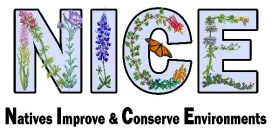 “Natives Improve and Conserve Environments” – NICE!
“Natives Improve and Conserve Environments” – NICE!
The program’s goals are to introduce people to great native plants that are available locally to use in place of non-native species.
The Kerrville and Fredericksburg NPSOT chapters collaborate on sponsoring the same plant each season. Texas is a large, diverse state and plants that work for one region may not always be the best choice in a different region. The NICE Native Plant Partners program helps nurseries offer natives that are right for the local environment.
“By putting the spotlight on one native plant each season, we hope to increase the public’s appreciation and demand for these great Texas natives, selected for our part of Texas, which will encourage the nurseries and wholesales to provide more of them.” – Cindy Anderson, NICE! program coordinator for Kerrville’s NPSOT chapter.
- Look for the NICE! sign stake at the local nurseries and professional growers listed below to identify the featured NICE! Plant of the Season.
- See examples of the current season NICE! plant at the NPSOT Native Plant Beds or in the meadow at the Riverside Nature Center.
- Information about previous NICE! plants is available here.
Participating NICE Nurseries
Our local NICE nurseries have happily agreed to stock up on our Plant of the Season in order to have it available to the public. These independent carry only the best plants for our area, as well as high-quality soil amendments and gardening supplies.
- Friendly Natives, 1107 Llano Street, Fredericksburg, 830-997-6288
- Medina Garden Nursery, 13417 Tx. Hwy 16, Medina, 830-589-2771
- Natives of Texas, 4256 Medina Hwy, Kerrville 830-896-2169
- Plant Haus 2, 604 Jefferson St., Kerrville, 830-792-4444
- The Gardens at the Ridge, 13439 S. Ranch Rd. 783 (Harper Rd.), Kerrville, 830-896-0430
- The Garden Haus, 109 West FM 473, Comfort, 830-995-5610


